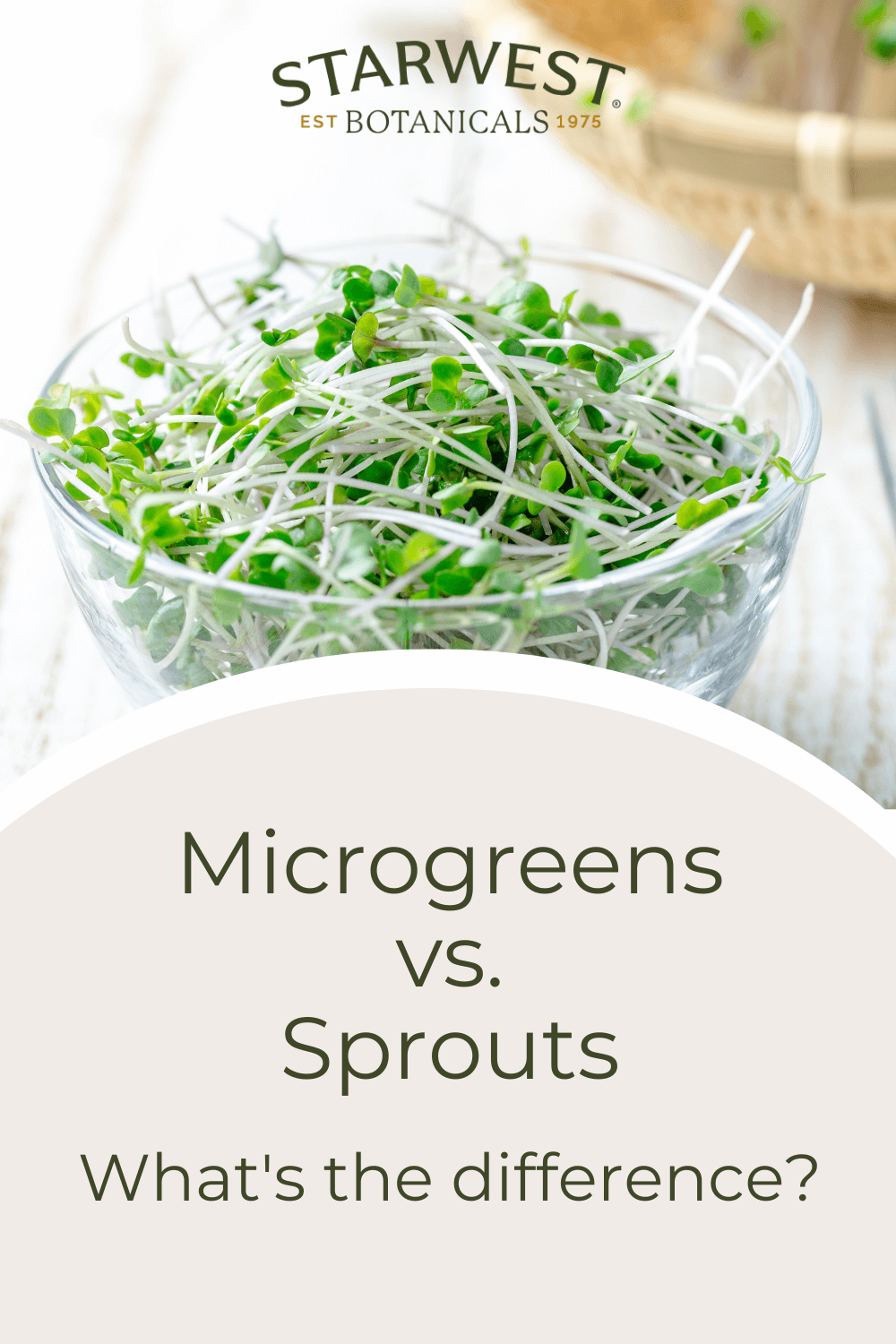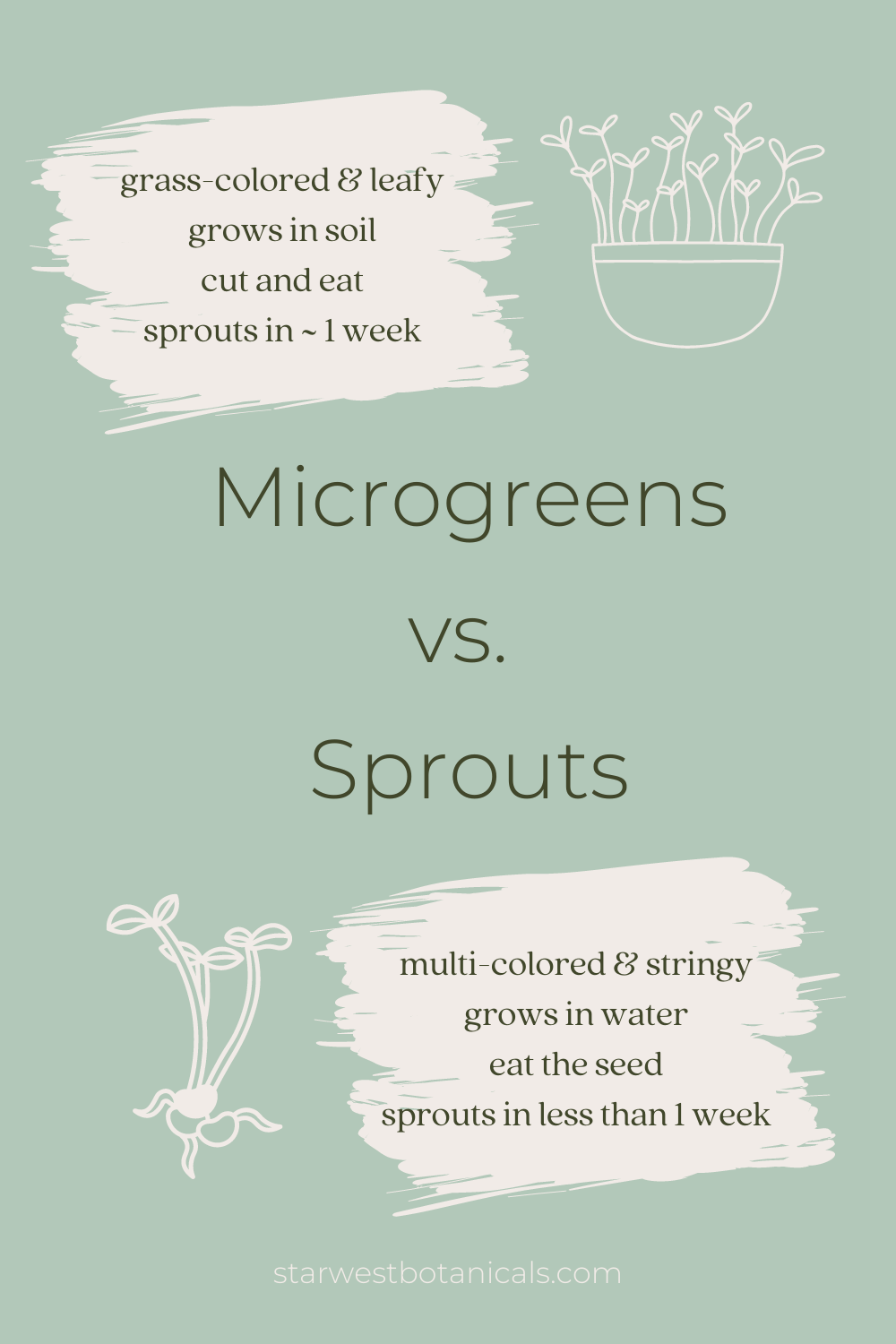Microgreens vs Sprouts: What's the Difference? | Starwest Botanicals
Posted by Starwest Botanicals Content Team | Medically Reviewed by Daniel Powers, MS on 07-16-2022

Small, green, and healthy—microgreens and sprouts may appear similar to those unfamiliar with either. But they aren’t the same. Simply put, microgreens are young, edible plants while sprouts are germinated seeds.
Sounds simple enough? There’s a lot more to uncover when exploring the difference between sprouts and microgreens.
From growing patterns to culinary use, this article is your ultimate guide to microgreens vs sprouts. Whether you're investigating these veggies for the first time or looking to add them to your diet, we have you covered. Read on to discover everything you need to know about sprouting seeds and microgreens.
How Can You Tell Them Apart?
The differences between microgreens and sprouts begin with what you can see. If you want to spot these two veggies at the grocery store or out in the wild, you’ll need a quick tutorial on what to look for.
Microgreens
As the name implies, microgreens are little and grass-colored, but there are a few critical details that make them stand out amongst the produce you’ll find at the grocery store. Consider the following aspects of microgreens' physical appearance:
- Leafy – Expect to find clovers and other forms of leaves growing from the top of microgreens. Perhaps the most identifiable aspect of this leafy vegetable is its small, circular leaves—they’re also where most of their flavor comes from.
- A few inches high – Microgreens live up to their name by staying on the short side. Typically, microgreens grow to only a few inches tall—they’re just high enough to harvest with a quick snip of gardening shears.
- Vegetable confetti – The popular nickname for microgreens is “vegetable confetti,” which refers to their small festive shape. While microgreens don’t come in as many vibrant colors as your standard party confetti, you may find deep purples, reds, and yellows in some strains of microgreens.
Sprouts
These sprouting seedlings are usually a little bit smaller than your standard microgreens, although they’re similar in density and growth pattern—making them easy to confuse at a distance.
Once you get up close, you’ll notice the following physical differences:
- Multicolored – Your standard sprout includes a brownish seed and a pale white or yellow sprout stem coming to a green-colored head. Color combinations may vary but sprouts are notable for their multicolored form, giving them a particularly earthy look.
- Stringy – While microgreens and sprouts both have stems, the sprout stems will appear more string-like and less like a typical plant stem. Additionally, sprout stems are often a bit gnarled and curved while microgreen stems typically grow straight up.
- Seed-based – It’s not a sprout without a seed. One of the easiest ways to tell microgreens and sprouts apart is the inclusion of a small brown kernel at one end of the stem. These pea-sized protrusions are easy to identify and edible, too.
How Do They Grow?
There are several commonalities between how to grow sprouts and microgreens. Both require plenty of water, grow quickly, and can be grown inside or outside. Of course, there are several differences between them as well.
Microgreens
There’s no such thing as a microgreen seed. While you may purchase microgreen seed packages, these seeds aren’t any different than your standard vegetable, herb, or flower seeds.
You can grow them in a mason jar, planter pot, or even outside in your garden. Consider the following steps for growing microgreens yourself:1
- Use fresh soil – Once you’ve selected your seeds, using fresh soil will be much more beneficial than using potting soil. Choose a soil that contains organic matter such as peat moss or compost, and add a few inches to your growing container. Moisten the bottom layer of soil with water before sprinkling your seeds on top. Finally, add another thin layer of soil on top of your seeds.
- Keep it damp – When growing microgreens, you don’t need to soak them. Instead, keep the soil damp at all times with a light misting. Depending on the environmental conditions, you may need to mist your microgreens a few times a day.
- Plenty of light – Like most plants, microgreens crave light. Whether you’re using high-watt LED plant lights or the power of the sun, luminescence is essential to grow microgreens.
Your microgreens should take less than a week to begin sprouting, and once they’ve grown a couple of inches, this leafy vegetable is ready to harvest. Most microgreens won’t grow back after you’ve cut them. Fortunately, it won’t take long to grow microgreens in a new batch.
Sprouts
Sprouts grow even faster than microgreens. You can expect a full batch of sprouts to develop in under a week. Find a dim place with plenty of airflow to begin growing sprouts, and choose a mason jar or container that can easily fit your seeds.
Sprouts are grown using the following methods:2
- Soaking and rinsing – When you’re ready to grow sprouts, soak your seeds to begin the germination process. Leave your seeds overnight fully submerged in a container of water. After 8-12 hours, you can drain and rinse your sprouts. Continue to rinse your sprout seeds a few times a day to avoid the growth of harmful bacteria, and keep them in a clean, room-temperature environment.
- Regular upkeep – You’ll want to keep your sprouts moist and encourage good airflow as they begin to develop. Consider shaking the container to ensure your sprouts have space to grow, otherwise, your sprouts may clump together, which could hinder their growth and lead to harmful bacteria problems.
- Drying and storing – Once your seeds have completed the sprout stage, you’ll need to dry your sprouts and store them in an airtight container in your refrigerator.
Keep a close eye on your sprouts after you’ve stored them. Like all organic material, sprouts will begin to turn bad after a period of time. If you notice unpleasant smells or discoloration, it’s time to toss your sprouts and start again.
What Are The Different Varieties?
Sprouts and microgreens are broad terms. In fact, there are dozens of different varieties of both microgreens and sprouts. Let’s explore a few common varieties of each.
Microgreens
If you’re not growing them yourself, you’ll likely find microgreens sold whole and ready to be cut and harvested at home. Whether you’re shopping for seeds or live plants, you’ll have plenty to pick from.
Some of the most popular microgreens include:
- Leafy greens – Lettuce, arugula, and spinach.
- Gourd plants – Cucumber, melon, and squashes.
- Onion plants – Chives, leeks, and garlic.
- Herb plants – Parsley, dill, and fennel
Every microgreen variation has its own unique flavor profile, ranging from bitter and acidic to light and sweet.
Sprouts
All sprouts begin as seeds or legumes, germinating and growing a range of edible sprouts. You may have common sprout seeds already in your cupboards.
While there are several more exotic sprout options, frequent favorites include:
- Lentil sprouts
- Chickpea sprouts
- Broccoli sprouts
- Soybean sprouts
- Pea sprouts
- Alfalfa sprouts
- Sunflower sprouts
- Mustard sprouts
Expect a range of tastes and textures between these diverse sprout varieties. Chewy, crunching, earthy, and nutty—sprouts can be as surprising as they are delicious.
What Are They Used For?
You’ve researched your sprouts and microgreens, figured out the best way to grow and harvest them, and even explored the wide range of options available for each, but what about using them?
Microgreens and sprouts may be nice to look at, but they’re far better as an addition to your next meal. Most importantly, there are many health benefits of sprouts and microgreens. Consider the plethora of ways they could make it onto your plate.
Microgreens
You’ve always been told to eat your greens, and today you can do it in a whole new way. While microgreens aren’t a substitute for standard vegetables (they’re simply too small), they are a great dietary addition.
Explore a few of their most popular uses:
- Garnishes – The cherry on top or, in this case, the leafy green on top. The subtle and distinctive tastes of microgreens make them perfect garnishes. Top your burger, sprinkle them over grilled fish, elevate your cocktails, and explore how a dash of microgreens can expand your palate.
- Salads – Microgreen salads are becoming a modern delicacy. Not only do they provide a fresh and fun texture with every bite, but they can be perfect for sharable portions and lend themselves to a variety of salad styles.
- Juices – From solid to liquid, microgreens make delectable additions to green juices. You can look forward to a burst of flavor, and you may even feel an energizing boost. Microgreens pair nicely with carrot, ginger, apple, and other juice staples.
Sprouts
Sprouts have been a part of many countries’ culinary cuisines for centuries. Today, there are more options than ever for enjoying them.
Take your sprouts for a culinary adventure in any of the following meals:
- Stir-fries and rice dishes – If you’re a fan of traditional Chinese cuisine, you’ve likely already encountered sprouts topping some of your favorite dishes. Of course, sprouts aren’t limited by tradition. They’ll add something special to a range of rice dishes and stir-fries.
- Smoothies – Sprouts are a popular addition to classic smoothies. Toss a handful into your blender along with the rest of your ingredients, or sprinkle them on top for an added crunch.
- Batters and pastes – Get inventive with your sprouts by emulsifying them. You could craft an appetizing dip or even a unique batter for baking or frying.

Starwest Botanicals: Explore Sprout Seeds, Herbs, Oils, and More
For those interested in health and wellness, microgreens and sprouts both offer a range of benefits. Now that you’ve explored a bit about both, you’ll have no problem selecting either for growing and eating.
Interested in diving further into the world of natural health? Visit Starwest Botanicals for an honest, friendly, and fully-organic experience.
In our four decades of business, we’ve maintained our commitment to quality organic herbs, essential oils, sprouting seeds, and more. That means traceability and transparency are at the forefront of everything we do. Explore our shop to discover outstanding wellness products and customer service to match.
Sources:
Vegetarian Society. Sprouting: How to sprout at home. https://vegsoc.org/lifestyle/sprouting-how-to-sprout-at-home/
Almanac. Growing Sprouts vs. Microgreens. https://www.almanac.com/growing-sprouts-vs-microgreens


